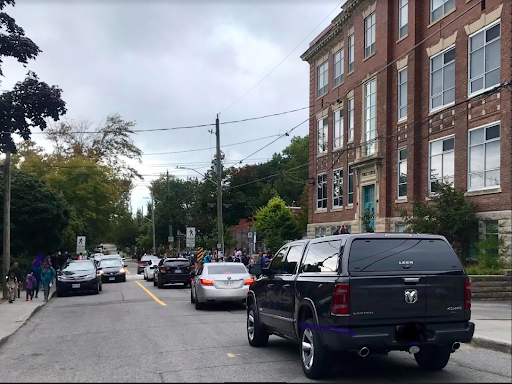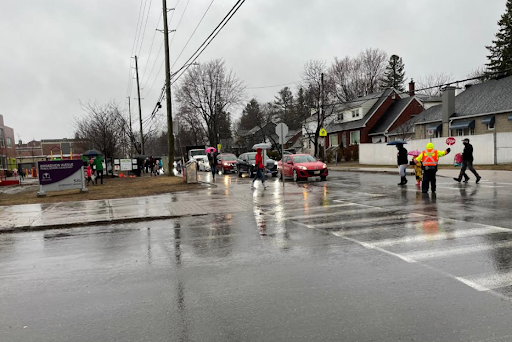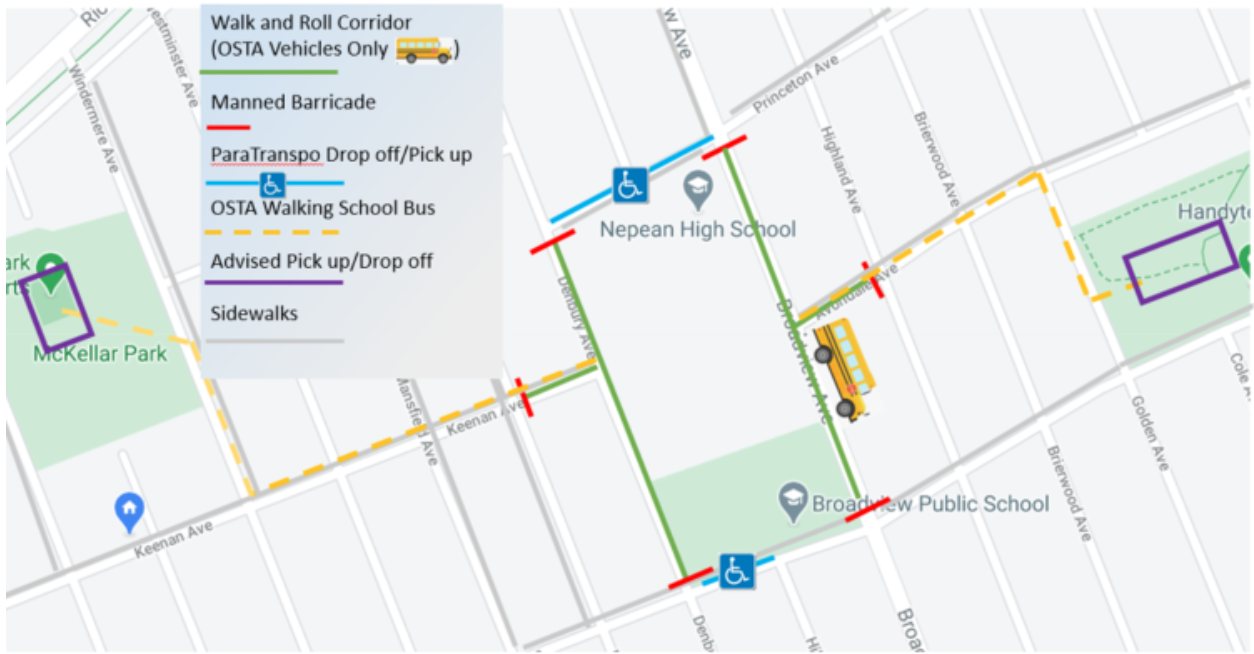In this guest post, Chris Hircock proposes making the streets in front of schools safe during dropoff and pickup.
The first month of kids returning to school has been a challenge for many reasons, one of which is simply how do we get there? At the time writing, the news in Ottawa is that school bus transportation is being cut back or cancelled due to a driver shortage, LRT service is suspended indefinitely following the latest derailment, and dozens of OC Transpo busses are being removed from urban routes for its replacement service. And let us not forget that Ottawa is two years into its declaration of a Climate Emergency. Bike Ottawa advocates for street designs that make it safe and easy for kids to ride their bikes. However, where Ottawa’s car priority streets were already at odds with making active and independent travel safe for kids, we now see even greater vehicular traffic at drop off and pick up times at schools. This not only presents a safety risk to kids already on foot and bike but it discourages many parents and kids to consider making the trip outside of their car.
You can see why anyone would choose not to ride a bike when you look at a common scene in the city: hundreds of kids converge upon a school within a short time, line ups of traffic at the school drop off lead to high stress points between people walking and drivers at crosswalks and corners. This is exacerbated by the city’s parsimonious sidewalk space; many kids take to walking on the streets to allow for adequate distancing due to COVID. Now more than ever is the time to give kids a safe way to get to school.
Let’s define the problem by looking at the traffic composition between active modes of transport (walking, biking) and those single vehicle school drop offs. A 2020 survey by Ottawa Student Transportation Authority (OSTA) found that parents reported their kids’ trips made to schools in the greenbelt are 6% by bike, 27% by walking, 19% by car. Take for example Broadview, Mutchmor, or Hopewell Ave schools, each having about 800 students, they would see approximately 150 of those students being dropped off directly at the school any given day (schools outside the greenbelt see slightly higher numbers of parents driving all the way). Google traffic data for pick up and drop off times at Broadview PS further illustrates OSTA’s findings, showing that much of the vehicular traffic that poses a safety risk to students is locally generated and due to the drop off and pickup, 150 vehicles would cause significant congestion in any residential community. While the numbers say one thing the experience is another, it can be very intimidating to the most seasoned rider, let alone a child, to walk or ride in proximity to so many drivers.


On the right: Illustration of traffic density during a weekday drop off and pick up times as compared to 12pm weekday traffic. Source: Google maps.
We know that much of the traffic around the school is locally induced by the drop off, what if we can disperse, or better yet, evaporate traffic? The good news is that this is entirely possible using a solution that has been tried across European and North American cities with unparalleled success: The School Street. A School Street is a temporary exclusive walking and biking corridor during drop off and pick up times, usually carried out with temporary barriers. The objectives of a school street are to:
- Create a safe environment for kids to safely walk and bike to school;
- Encourage healthy active travel and promote independent mobility;
- Reduce locally generated congestion in the community; and
- Support physically distancing needs due to COVID 19.


On the right: Example of a School Street corridor
As a leading example the city of Vancouver piloted a School Street at 3 schools as a part of its School Active Travel Program in April 2021. The report following the pilot found that 29% of families reported driving less, 32% of families walked more; 76% of parents wanted the School Street to continue. Following the success of the pilot, School Streets are being implemented at 3 schools for the rest of the 2021/22 school year.
I proposed the idea in my own community of McKellar Park/Highland Park about 6 months ago for Broadview public school, located in a walkable catchment area it would lend itself well to a School Street pilot. In drafting the proposal, I have been in touch with both parents and crossing guards across Ottawa about the issue of local drop off and pick up traffic. The frustration is palatable and the issues are common; we know drivers and kids do not mix on the streets around our schools, so why can’t we make a space exclusive of cars and inclusive of kids. For many communities a school street could complement walking School Bus programs already in place, and be a natural progression of some tried walk-a-block programs. Further, it can be done in a way that minimizes any inconvenience or delay to parents who would still choose to make a vehicular drop off, in fact it could save time where they do not experience localized traffic delays. Image 2 shows one example of how a School Street could work for Broadview Public School.
Notes:
1. School Street to be set up at 9:00 to 9:30am and 3:40 to 4:10pm using temp barriers, OSC crossing guards and a volunteer pool.
2. Only OSTA vehicles would be permitted on Broadview Ave during street closure.
3. Advisory pick up and drop off areas located at Dovercourt and McKellar Field House with assistance of the OSTA Walking School Bus or similar program.
4. Drop off and pick up locations anywhere outside the School Street as city bylaws permit.
As for what I have done so far in my community of McKellar and Highland Park: prior to the April school shut down I proposed a pilot School Street to the school principals and the community associations, and concerned parents. I am pleased to say that the community associations have provided unanimously positive feedback and ask to be involved as the proposal progresses. However, challenges remain and every detail has to be addressed, including mail outs to residents, media campaigns, online promotions, traffic counts, and having a labour pool for the set up and take down of the streets. At present the burden is on the active transportation advocate to prove that a School Street can work, however it is the city whose resources and leadership that we need make it happen.
Which brings us to Ottawa’s Transportation Master Plan, the first element is “to reduce automobile dependence” with a key principle being to “make walking and cycling more attractive than driving for short trips”. Seeing that Ottawa has both the TMP and a declaration of Climate Emergency on which to act, we have our community associations’ endorsement, and parents demanding safe options to get their kids to school, what else would the city need to pilot a city-wide School Street program?
At a time when Ottawa is faced with a school bus driver shortage, an immobilized public transportation network, we are ready now more than ever to have the city deliver on its own policy priorities. The time is now for the city of Ottawa, along with the school boards and partner organizations, to lead with a School Street program so that kids have safe and healthy options to travel to school.
A final word: You have a community at Bike Ottawa who is a voice for active transportation advocacy in Ottawa, one who seeks to create a healthier, more vibrant community for everyone. Please consider taking out or renewing your membership, with each new member our voice becomes stronger.

